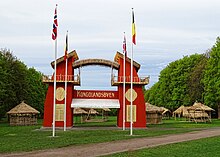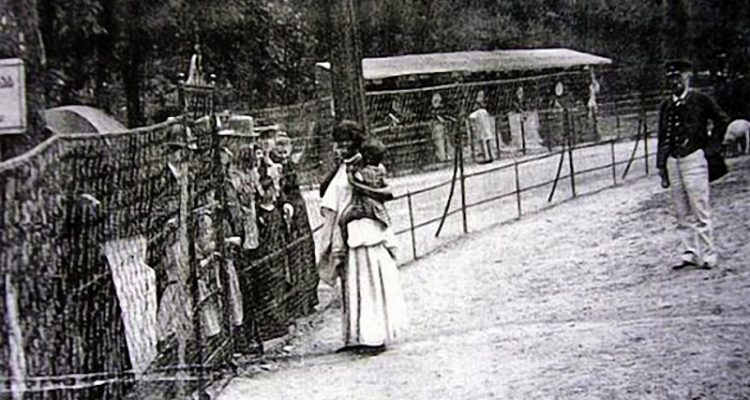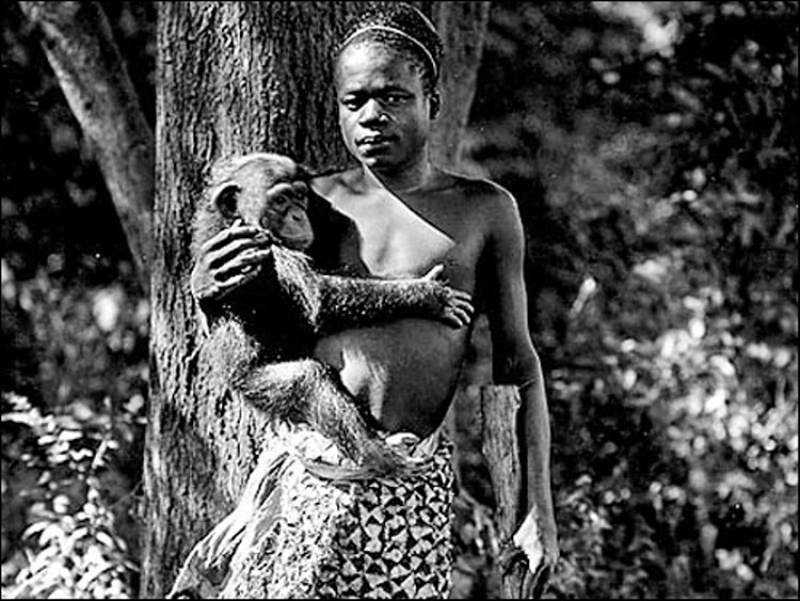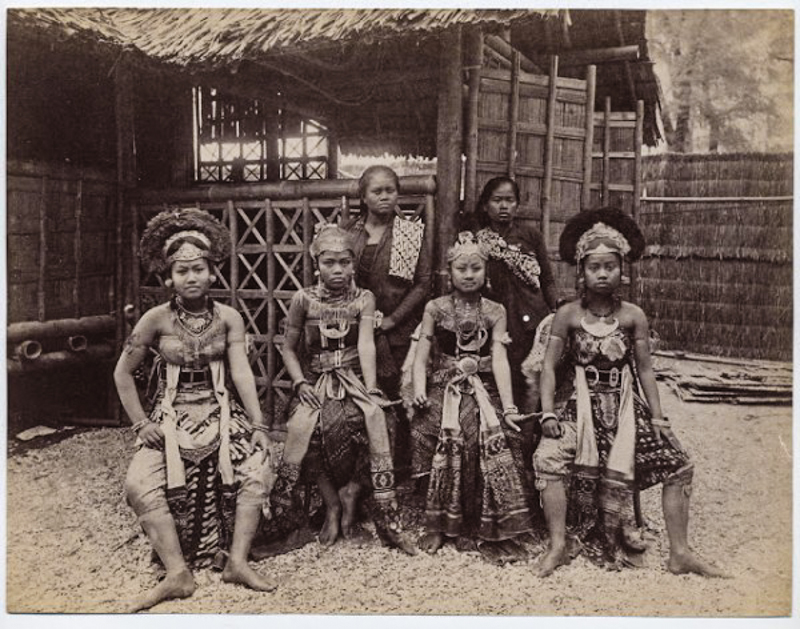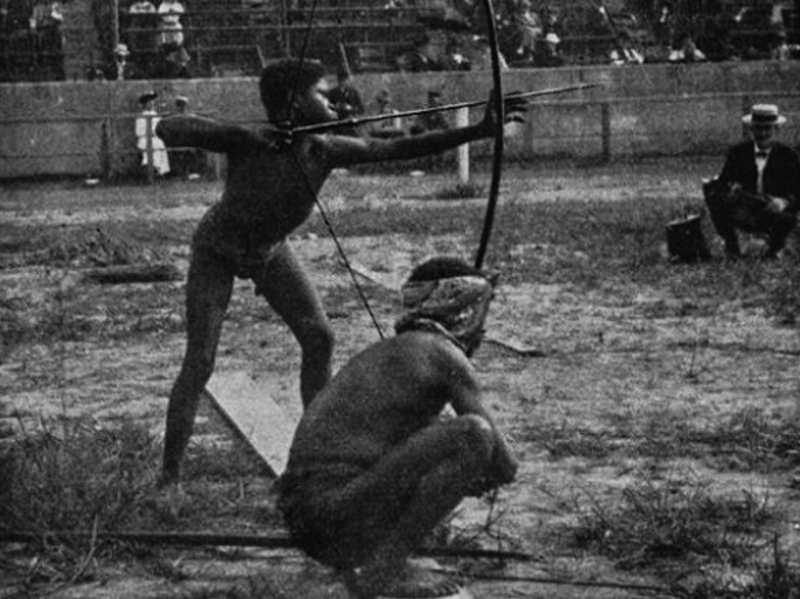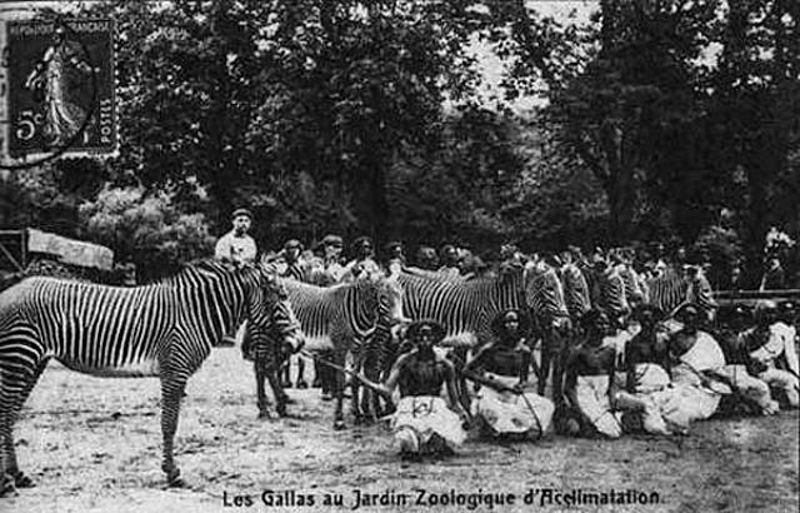https://en.wikipedia.org/wiki/Human_zoo#1940s_to_the_present
http://www.bbc.com/news/magazine-16295827
https://www.theguardian.com/world/2014/apr/29/norway-human-zoo-africans-as-inmates
http://gawker.com/5875175/human-zoo-allowed-tourists-to-throw-bananas-at-islanders
'Human Zoo' Allowed Tourists to Throw Bananas at Islanders
1940s to the present[edit]
The concept of the human zoo has not completely disappeared. A Congolese village was displayed at the Brussels 1958 World's Fair.[17] In April 1994, an example of an Ivory Coastvillage was presented as part of an African safari in Port-Saint-Père, near Nantes, in France, later called Planète Sauvage.[18]
An African village, intended as a craft and cultural festival, was held in Augsburg Zoo in Germany in July 2005, and was subject to widespread criticism.[19] In August 2005, London Zoo displayed four human volunteers wearing fig leaves (and bathing suits) for four days.[20]In 2007, Adelaide Zoo ran a Human Zoo exhibition which consisted of a group of people who, as part of a study exercise, had applied to be housed in the former ape enclosure by day, but then returned home by night.[21] The inhabitants took part in several exercises, much to the amusement of onlookers, who were asked for donations towards a new ape enclosure. In 2007, pygmy performers at the Festival of Pan-African Music were housed (although not exhibited) at a zoo in Brazzaville, Congo.[22] February 21, 2016 an editorial by Jerry Fredrickson in the Duluth News Tribune in Duluth, Minnesota suggested adding a Native American encampment to the Lake Superior Zoo in order to "bring tourists by the busload." [23]
See also[edit]
References[edit]
- ^ Mullan, Bob and Marvin Garry, Zoo culture: The book about watching people watch animals, University of Illinois Press, Urbana, Illinois, Second edition, 1998, p.32. ISBN 0-252-06762-2
- ^ Mullan, Bob and Marvin Garry, Zoo culture: The book about watching people watch animals, University of Illinois Press, Urbana, Illinois, Second edition, 1998, p.98. ISBN 0-252-06762-2
- ^ "The Museum of Hoaxes". Museum of Hoaxes. Retrieved 11 April 2016.
- ^ "On A Neglected Aspect Of Western Racism" by Kurt Jonassohn, December 2000, Montreal Institute for Genocide and Human Rights Studies
- ^ Roberto Aguirre, Informal Empire: Mexico And Central America In Victorian Culture, Univ. of Minnesota Press, 2004, ch. 4
- ^ a b "Man and Monkey Show Disapproved by Clergy", The New York Times, September 10, 1906.
- ^ "Discover Paris! - Newsletter". Retrieved 11 April 2016.
- ^ See Charles Dudley Arnold's photo similar human displays had been seen of six men dressed in Native-American costume, in front and on top of a reconstruction of a Six-Nations Long House.
- ^ Anne Maxell, "Montrer l'Autre: Franz Boas et les soeurs Gerhard", in Zoos humains. De la Vénus hottentote aux reality shows, Nicolas Bancel, Pascal Blanchard, Gilles Boëtsch, Eric Deroo, Sandrine Lemaire, edition La Découverte (2002), pp. 331-339, in part. p. 333,
- ^ Cincinnati Zoo and Botanical Garden, Ohio Historical Society.
- ^ Jim Zwick (March 4, 1996). "Remembering St. Louis, 1904: A World on Display and Bontoc Eulogy". Syracuse University. Retrieved 2007-05-25.
- ^ "The Passions of Suzie Wong Revisited, by Rev. Sequoyah Ade". Aboriginal Intelligence. January 4, 2004.
- ^ Bradford, Phillips Verner and Blume, Harvey. Ota Benga: The Pygmy in the Zoo. St. Martins Press, 1992.
- ^ a b c d
Human zoos: When real people were exhibits
- 27 December 2011
- Magazine
Curator Nanette Snoep gives a tour of the Savages exhibition
An exhibition in Paris looks at the history of so-called human zoos, that put inhabitants from foreign lands, mostly African countries, on display as article of curiosity.Over four centuries from the first voyages of discovery, European societies developed an appetite for exhibiting exotic human "specimens" shipped back to Paris, London or Berlin for the interest and delectation of the crowd.What started as wide-eyed curiosity on the part of observers turned into ghoulish pseudo-science in the mid-1800s, as researchers sought out physical evidence for their theory of races.Finally, in high colonial times, hundreds of thousands of people visited "human zoos" created as part of the great international trade fairs.Here they could watch whole villages of Kanaks or Senegalese, with real-life inhabitants paid to act out war dances or religious rituals before their colonial masters.The story is told at the Quai Branly museum in Paris until June 2012, mainly through the display of paintings, old photographs, archive film, posters and postcards.The aim of the exhibition is explicit - to teach how Western societies created a sense of "the other" in regard to foreign peoples, thus legitimising their eventual domination.
"What we tried to do is conduct a kind of archaeology of the stereotype," says curator Nanette Snoep.The display, entitled "Inventing the Savage", was the inspiration of the Caribbean-born former international footballer Liliane Thuram, who today heads his own anti-racism foundation."I have long been interested in slavery because of the way my own family was affected by it," says Thuram."It became clear to me that racism was above all an intellectual construction. And as such, it was also susceptible to de-construction."That's what we are trying to do with the exhibition: putting on display the information that allows people to understand why there are still faultlines in society based on the colour of our skins."At the start, all was relatively innocent. One of the first paintings is of four Greenlanders brought to the Danish court in 1664 by a Dutch sailor. They stare out with a look as bewildered as those that must have been on the faces of their captors."What is fascinating is that on top of the painting are written their names. In other words, at this early stage they are seen as individuals. Exotic yes, but people," says Snoep. "It is later when the names disappear that the relationship deteriorates."Another early portrait is of the Tahitian man called Omai, who was brought to the court of King George III in London by the explorer Joseph Banks.
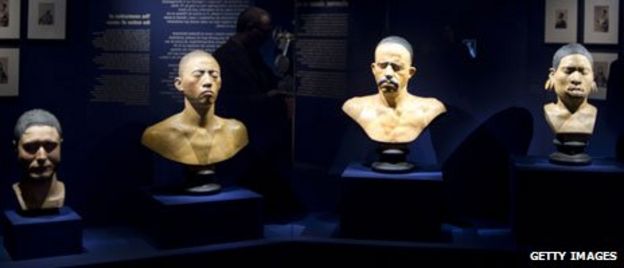
Ethnographic displays disappeared after World War II
In his book The Age of Wonder, Richard Holmes describes Omai as "quick-witted, charming and astute. His exotic good looks… were much admired in society, especially among the more racy of the aristocratic ladies."But describing this same portrait, Holmes adds: "It is not clear if [Omai] is Banks's companion or his trophy."Guest or specimen? If there was room for ambiguity in the early days - when explorers and explored often found each other mutually intriguing - this disappeared with the new certainties of the colonial epoch.The saddest emblem of the coming era was the South African Saartjie Baartman, later to be known as the Hottentot Venus. Born around 1780, she was brought to London in 1810 and put on display.She had the genetic characteristic known as steatopygia - extremely protuberant buttocks and elongated labia - which evidently delighted the cabaret-goers of the British capital.
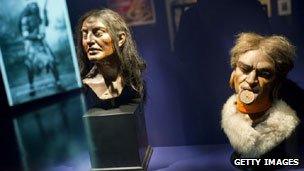
Can it teach us anything about modern attitudes to race?
Later she came to Paris, and was analysed by the budding racial anthropologists. According to the exhibition catalogue, one scientist described her as having the "buttocks of a mandrill".When she died in poverty, her skeleton was put on display. It remained on show in the Museum of Mankind in Paris until 1974. In 2002, her remains were repatriated and buried in South Africa."Baartman marks the start of the period of description, measurement and classification, which soon leads us to hierarchisation - the idea that there are lesser and greater races," says Snoep.The climax of the story comes with the imperialist high noon of the late 19th and early 20th Centuries.A European public fed on notions of Christian evangelism and cultural superiority was titillated by re-enactments of life in the colonies which became a regular part of international trade fairs.Entrepreneurs put on travelling stage shows featuring Hindu rope-dancers, Arabian camel-herders, Zulu warriors or hunters from New Caledonia. Whole African villages were recreated to allow Europeans a glimpse of "primitive" living.The most famous impresario was "Buffalo Bill" Cody whose Wild West shows - according to the exhibition organisers - were another example of racial stereotyping.
Some 35,000 people are reckoned to have taken part in the displays. Most were paid."They were shows. Public entertainment. The villagers from Africa or India were acting out a role. Significantly there were barriers between the public and the performers, to reinforce the notion of separateness," says Snoep.These ethnographic displays died out after World War II. Oddly it was Hitler who first banned them. The last was in Belgium in 1958.The organisers of Inventing the Savage claim that these "human zoos" were seen by 1.4 billion people overall - and that they therefore played an important, and so far unacknowledged, part in the development of modern racism."What is left of this incredible story today?" intones the voice-over on a film which is part of the exhibition."A view of Africa and its people that is still contemptuous. A certain way in the West of believing oneself superior. Above all the story helps explain how millions of westerners were manipulated into a belief in the inequality of races."Inventing the Savage provides plenty of food for thought, and there is no-one alive today who would for a minute defend the practice of human ethnographic exhibitions.
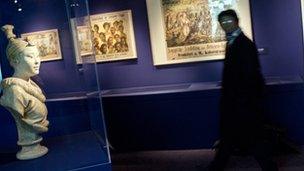
Belgium hosted the last such display in 1958
The show has been well-received but has come into some criticism for what some see as its heavy-handed didacticisim - as well as a kind of historical cherry-picking that leaves out what does not fit the message.There is no mention for example of what the human "exhibits" themselves thought when brought to Europe. They are presented as victims, nothing more. Nor are the reactions of the audience explored. Maybe these were more complex than mere colonial self-satisfaction.Writing in the left-wing newspaper Libération, columnist Marcela Iacub detects in the show "the frankly conservative role… of militant anti-racists and the consensus that they seek to create."The spirit of the exhibition, she says, is a kind of "censorship, accompanied by the promotion of pedagogical, uplifting messages that will eradicate in us all those dangerous ideas that survive."Iacub says it is ironic that it was just that kind of misguided moral superiority - the need to improve the unenlightened - that led to Europeans colonising Africa in the first place."In the eyes of the militant anti-racist, we are all violent, easily manipulated, barbarous, bloodthirsty, and incapable of thinking without the aid of people to teach us. In fact just like the 'savage' of old!"

